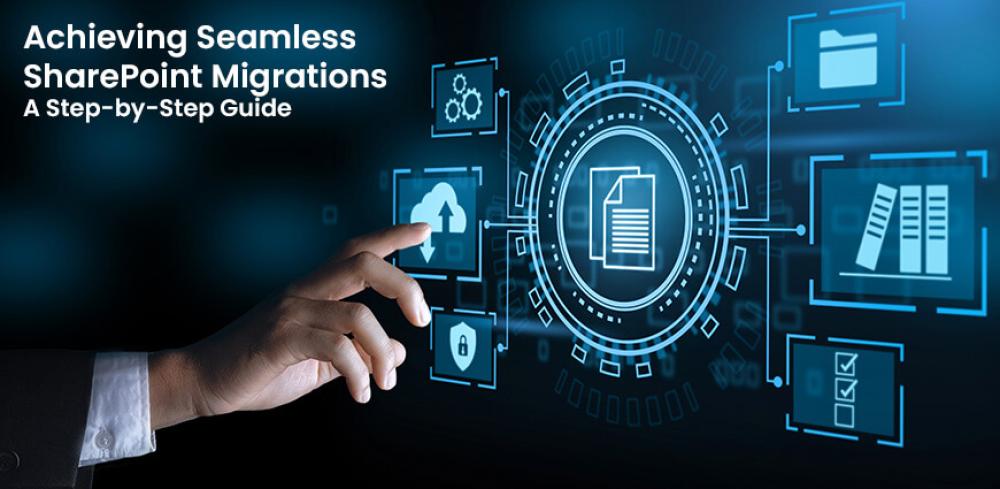SharePoint is a potent collaborative platform from Microsoft that has proven essential for any organization trying to improve productivity, centralize data, and simplify processes.
As more companies became aware of SharePoint's advantages over time, they started upgrading to newer versions, streamlining existing configurations, or switching to SharePoint Online. Today we'll look at ways to make SharePoint migrations go well.
1. Assessment and Planning
It's important to perform a comprehensive review of your current environment before starting any SharePoint move. This involves assessing the modifications, data, and content in the SharePoint setup you currently have. Take a moment to ask yourself these questions:
-
What content needs to be migrated?
-
Are there any custom solutions or workflows that must be transferred?
-
What are the compliance and security requirements for the new SharePoint environment?
After you have a comprehensive understanding of your existing situation, create a thorough migration plan. This plan should specify the resources, schedule, and extent of the migration.
At this point, professional advice and Microsoft SharePoint consulting services may be quite helpful in making sure your strategy is thorough and in line with your company's objectives.
2. Preparing Your Environment
The health of your current environment has a significant impact on the success of your SharePoint move. Make sure your original SharePoint system has the most recent upgrades and fixes installed before beginning the migration. Check your storage as well to make sure it can hold the data that needs to be moved.
3. Data Cleanup and Organizing Content
Cleaning up and organizing your material is an important part of getting ready for a SharePoint migration. This is removing data that is superfluous, redundant, or out-of-date that does not need to be transferred to the new environment.
Sort your material into sensible categories and think about updating your information architecture to make the most of the new SharePoint setting.
4. User Communication and Training
While migrating SharePoint, it's critical to communicate effectively with your end users. Both the modifications and the new platform's usage must be understood by them. Create a communication plan that includes:
-
Announcement emails or messages
-
Training sessions or resources
-
User guides and FAQs
To assist you in developing and implementing a user training and communication plan, think about engaging Microsoft SharePoint consulting services.
5. Backup and Disaster Recovery
Having a solid backup and disaster recovery strategy in place is essential before starting the migration. This guarantees that, should something go wrong during the migration, you can simply go back to the initial condition. You should include regular backups of your source environment into your daily operations.
6. Choosing the Right Migration Method
Selecting the best migration method is essential for handling complex SharePoint migrations. Your budget, the size of the transfer, and the unique requirements of your company will all influence the approach you choose. Common migration methods include:
Manual Migration:Small-scale migrations can benefit from this method, which includes physically moving data.
Third-Party Migration Tools:The migration process may be streamlined with a variety of third-party solutions, particularly for larger-scale operations. For a seamless transfer, these tools frequently include functions like reporting, scheduling, and problem management.
Also, cloud transfer services like AWS Data Migration Service, Google Cloud's Transfer Service, and Microsoft's Azure Migration Tools provide extensive support for migrating vast amounts of data between different platforms, databases, and storage systems.
Hybrid Migration:
A hybrid solution could be required if you're moving from on-premises SharePoint to the cloud, enabling you to integrate on-premises and cloud resources while the migration is underway.
Microsoft's SharePoint Migration Tool:
A free SharePoint Migration Tool is available from Microsoft and is appropriate for modest to medium-sized migrations.
The unique demands and objectives of your organization should be carefully evaluated before choosing the best migration method.
7. Testing and Validation
Never skip the testing stage. Run test migrations to find and fix any possible problems before moving all of your material. This will assist you in improving your migration strategy and guarantee a seamless transfer. You may also confirm through testing that your workflows and customizations work properly in the new environment.
8. The Actual Migration
It's now time to carry out the migration once all the testing and preparations have been finished. The difficulty and duration of this step might vary depending on the approach selected. Keep a careful eye on the migration process's development and be ready to handle any unforeseen difficulties that may come up.
9. Post-Migration Activities
Migrating your content is just the beginning. Following the migration, you'll need to carry out a number of post-migration tasks, such as:
-
Verifying data integrity and consistency
-
Updating links and references
-
Validating custom solutions and workflows
-
Conducting user acceptance testing
-
Continuously monitoring the new SharePoint environment
10. Ongoing Support and Optimization
After the actual migration is over, your SharePoint migration adventure continues. Maintain regular contact with your end users to guarantee a smooth transition. Provide training, attend to their problems, and be ready to make changes in response to user input.
Also, if your organization's demands change, be sure to periodically assess and enhance your new SharePoint environment.
It takes careful preparation, competent execution, and continuous assistance to accomplish a flawless SharePoint migration. From the first evaluation to the post-migration actions, every facet of your move must be taken into account.
In order to make sure that your migration strategy is thorough, implemented efficiently, and customized to your organization's specific needs, working with Microsoft SharePoint consulting services might be a beneficial step.
You can reduce downtime and maximize the benefits of your new SharePoint environment, improving productivity and cooperation throughout your company, by following these step-by-step instructions.









